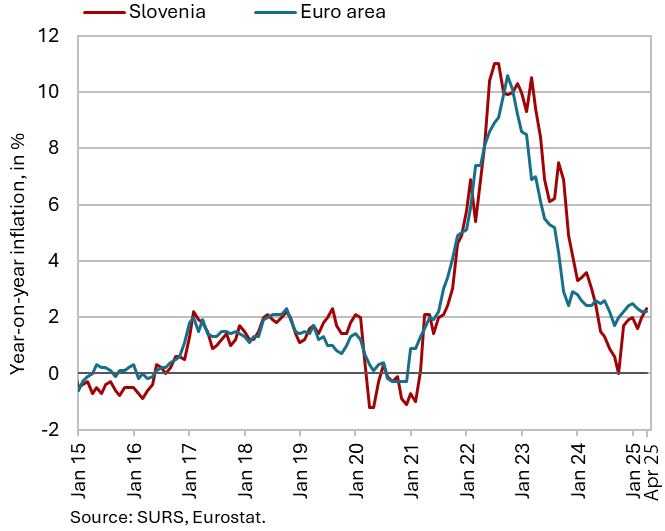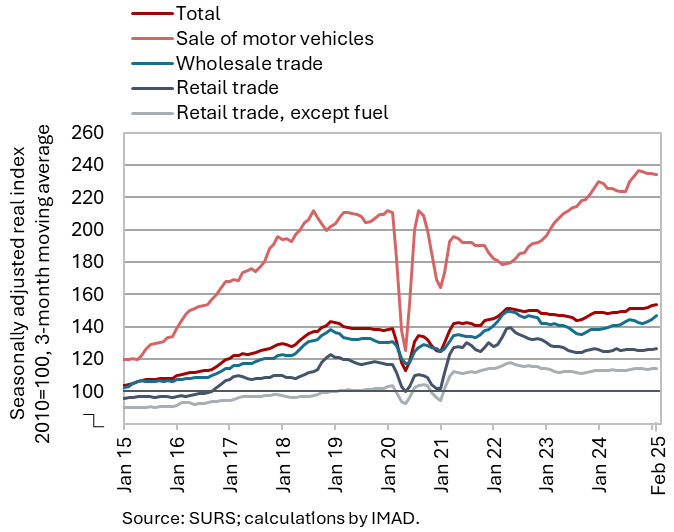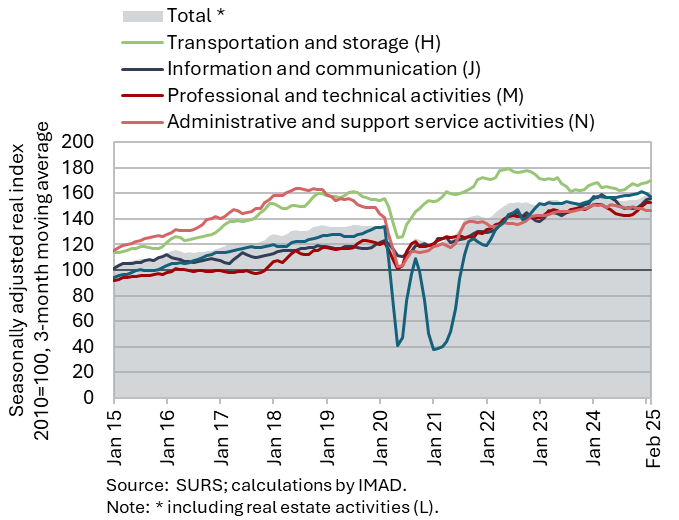Charts of the Week
Charts of the week from 28 to 30 April 2025: consumer prices, turnover in trade and turnover in market services
Consumer prices rose by 2.3% year-on-year in April, marking the highest increase since May 2024. The largest contributions came from higher prices of food and non-alcoholic beverages, partly due to base effect, and from seasonal increases in footwear prices. In February, turnover declined across all market service activities, with the exception of real estate activities. Within trade, turnover fell in the sales of motor vehicles and food products, while it increased in wholesale trade and sales of non-food products. In the first two months of the year, turnover in market services was lower year-on-year, while it increased in trade.
Consumer prices, April 2025

Year-on-year growth of consumer prices increased further in April, by 0.3 p.p., reaching 2.3%, the highest level since May 2024. The main contributor to higher inflation were higher prices of food and non-alcoholic beverages, which increased by 5.9% year-on-year (compared to 3.5% in March). This was the highest growth rate among all 12 CPI groups of goods and services. In addition to the monthly increase in vegetable and meat prices, a significant contributor to the higher year-on-year growth was also the lower base from April last year, when food and non-alcoholic beverage prices fell by 1% month-on-month (in April this year, they increased by 1.2% month-on-month). Inflation was also pushed up by an above-average seasonal increase in footwear prices (20% on a monthly basis), which raised the year-on-year growth in prices of semi-durable goods to 3.9% (2.2% in March); the prices of durable goods remained lower year-on-year (–0.3%). The year-on-year growth of service prices declined slightly in April, but at 3.2% (March: 3.4%), it remained relatively high. Due to lower oil product prices on global markets and the depreciation of the US dollar, oil product prices in April decreased by around 3.5% month-on-month and were about 3% lower year-on-year.
Turnover in trade, February 2025

In February, real turnover increased in wholesale trade and sales of non-food products, while it declined in the sales of motor vehicles and food products; on average over the first two months, sales was higher year-on-year across all sectors. Wholesale trade and retail sales of non-food products increased in February for the second month in a row, following a decline in the fourth quarter of last year. Sales of motor vehicles and retail sales of food products, after increasing in January and declining in February, remained broadly unchanged on average in the first two months compared with the fourth quarter of last year, when a modest increase was recorded. On average over the first two months, turnover across all sectors was higher year-on-year, with the largest increases observed in wholesale trade (4%) and sales of motor vehicles (3%).
Turnover in market services, February 2025

Total real turnover in market services declined again in February and was also slightly lower year-on-year in the first two months. Following a sharp drop in January, turnover decreased further in February (by 1.4% seasonally adjusted), with declines recorded across all activities except real estate activities. The most pronounced drop was recorded in information and communication, where the downturn deepened further after strong growth at the end of last year. Turnover in transportation and storage also fell slightly (particularly in storage) following growth at the end of last year. Turnover in accommodation and food service activities declined for the second consecutive month, after having strengthened during the second half of last year. A slight decline was also observed in administrative and support service activities, continuing a downward trend observed since mid-2024. After five months of growth, turnover also declined in professional and technical activities. On average in the first two months of the year, total real turnover in market services was 0.6% lower year-on-year. Only turnover in professional and technical activities and transportation was higher year-on-year.
